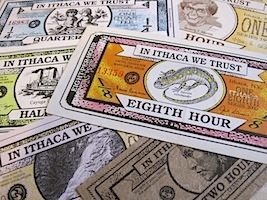Does
Ithaca Need Wal-Mart?
by Paul
Glover June 1994
We've
got another big decision to make. Wal-Mart is
asking the
people of Ithaca for permission to build the largest store in
Tompkins County within our city. Our choice, conveyed through the
Planning Board, should be considered carefully, because it will
dramatically affect this community's jobs and wages, traffic,
taxes, consumer prices, hospital access, flood control, tourism,
air quality, and wildlife.
Several of Ithaca's
leaders have reassured us that
Ithaca
would be a better place to live if Wal-Mart opens here. Ithaca's
mayor, Ithaca's daily paper, Ithaca's Planning Department,
Ithaca's Board of Zoning Appeals, and numerous enthusiastic
shoppers have opened our doors to them. They believe that the
city will gain jobs (or lose fewer), that the city and school
district will gain revenue (or lose less), that local businesses
will survive Wal-Mart by adapting, that consumers will have lower
prices and more choices.
The Wal-Mart
sponsored Impact Statements, however, (by
RKG
Associates and Sear-Brown Group), and the experiences and studies
of cities elsewhere, give us very different information.
TAX
REVENUE
We're told that City
Hall will gain $405,000 to $490,000
sales
and property tax yearly (less than 2% of the City's 1994 income)
if Wal-Mart locates in Ithaca. But the RKG consultants recommend
that downtown parking would need to be free to allow the Commons
to survive Wal-Mart competition (p.17). Free parking downtown
means a loss to the City of at least $865,000 per year ($725,000
downtown parking fees/year lost + $140,000/year cost for downtown
parking garage maintenance, staff, and bond payments:
1994 Ithaca City
Budget, pp. 50, 58-59, 61).
On this account alone
the City would suffer a net loss
of at
least $375,000- 460,000. Even if just half the downtown parking
revenues were lost because of Wal-Mart, to free parking days or
shift of shopper parking, the City would lose about $50,000 net.
At the same time, the
study Fiscal Impacts of Mall
Development
(Armstrong, 1989) indicates that each new major shopping mall
typically requires a city to hire two more police officers. These
officers would cost Ithaca a total of approximately $60,000.
There are plenty
other costs not calculated by the EIS.
The
City itself is already accepting a $250,000 bond burden, to fix
the Meadow Street/Elmira Road intersection that the Wal-Mart
study says would need widening to handle Wal-Mart traffic (1994
Ithaca City Budget p.63) Additional related upgrades would be
expected as traffic rises.
Nor would Wal-Mart
property taxes necessarily benefit
the
Ithaca City School District. About half of the district's state
aid is calculated as a ratio of students to equalized property
value. Thus, adding a multi-million dollar shopping mall to tax
rolls "could have a net negative impact" on District
income, according to Gary Lindenbaum, Assistant Supervisor for
Business Services of the Ithaca City School District. Yet no one
has asked that office for an assessment.
LOCAL BUSINESSES
There is an even more
serious loss to the city that the
study
did not calculate, from sales tax not collected because of loss
of multiplier sales provided by locally-owned businesses. That
is, the more each dollar bounces around town before leaving, the
more job creation, sales, and sales tax it generates. Every
dollar spent with a locally-owned business gets spent here an
estimated 2.3 more times than when spent with a company which
takes its profits out of town (ILSR Study, 1980). By this
formula, if 25% of the sales diverted directly and indirectly by
Wal-Mart are from locally-owned stores, then the sales tax loss
would total $182,000 more than RKG estimated (p. 14). This
multiplier benefit is lost when Wal-Mart replaces smaller local
businesses. The RKG study does not analyse this.
JOBS
The RKG EIS admits
that Wal-Mart would take jobs away by
killing businesses here today. "Because there is no obvious
source of unmet retail demand by the local population... a
greater portion of Wal-Mart's projected sales would need to be
captured from existing area stores (p.5)." This is expected
to be over $20 million per year (p.10), of which about $7 million
are lost by city stores. Mass merchandizers can expect losses
between 10% and 33%. Other stores would lose 2%-4% of sales.
Downtown businessman Jeff Furman remarks, "The Ithaca
Journal quoted the RKG study, saying only 4% of store income
would be lost. Four percent is a lot for these struggling small
businesses. We're talking about their margin for existing."
RKG's study admits as
well that "While some area
merchants could have absorbed a marginal reduction in sales to
new competition in years past, their ability to absorb future
sales losses has been weakened by the recession (p.85)."
Wal-Mart claims to
create so many jobs by selling so
much
stuff, that we wouldn't need the jobs lost in the stores that
close. The RKG study does not explain this conclusion. But a
Massachusetts study says a typical Wal-Mart adds 140 jobs and
destroys 230 higher-paying jobs (Donella Meadows, professor,
Dartmouth). Another independent study not purchased by Wal-Mart
(Humstone Associates, 1993) projected an expected net loss of 200
jobs in St. Albans Vermont, because Wal-Mart sales are less
"labor intensive" than small locally-owned businesses:
Wal-Mart employs 70 people for every $10 million sales, while
small retailers employ 106 people per $10 million sales
(Humstone, p.20). Why such different job estimates? The RKG
study, for example, does not include the closing of Woolworth's,
with dozens of jobs, even though "It can be assumed that a
major share of the transfer [of sales] would be borne by
Woolworth's and CVS Pharmacy (p.103)." A Wal-Mart in Ithaca
would have an impact like the Watertown Wal-Mart (p.76). The
Watertown Woolworth's saw a double-digit drop in sales, mostly
because of Wal-Mart there (p.xii).
The EIS does not
describe the closing of other Commons
businesses, or the loss of those jobs that follow from the
closing of Woolworth's. Nor does the EIS calculate the net job
change resulting from Wal-Mart's "induced development"
on Elmira Road, which takes even more business (>$1,000,000
sales) away from downtown.
The EIS quotes
business people who have survived the
five
Wal-Marts which surround Ithaca. Yet these are new Wal-Marts,
just one or two years old, which have not had time to do full
damage. The famous study by Kenneth Stone (The Impact of Wal-Mart
Stores, 1993), shows that business failures accelerate after
Wal-Mart has been in town three to five years. "While
Wal-Mart may be thriving, the decline in the rest of the stores
means that the net effect is a drop in the number of dollars
spent in town" (Stone, Mississippi Business Journal 6/88).
He adds, "the money a Wal-Mart drains from the community
won't come back; it isn't in the hands of local people who might
invest it back in the community. Then you lose a sense community
loyalty, that small town atmosphere, and you are in danger of
becoming a bedroom community. You don't have business and civic
leaders; you have transient managers." As the Valley News of
Plainfield, New Hampshire says, "Fewer merchandising profits
circulate within the community. Wal-Mart profits go to Arkansas.
Wal-Mart handles most of its insurance, legal services and
banking at its headquarters, too" (6/93).
As if these facts
were not ominous enough, the RKG
report
expects a sudden 10% leap in Wal-Mart sales taken from existing
stores, five years later, when it expands to 155,000 square feet.
After ten years, Wal-Mart would be taking 17 million dollars per
year from businesses here today (p.96). "The Ithaca Wal-Mart
will be one of the chain's largest area stores (p.8)," with
45% of the floor area of competitive stores on the Commons. Their
parking lot, 50% larger than Wegmans, would be so large that
shoppers would walk 560' (one ninth of a mile) from the farthest
parking spot to an entrance. To get an idea how big this mall
& lot would be, walk around all four Commons blocks (bounded
by Aurora, Cayuga Seneca and Green).
TOURISM
There is no analysis
of the loss of tourist dollars from
this
Wal-Mart and related urbanization. People come to Ithaca to visit
a small city and big lake, surrounded by forests and waterfalls.
They do not come to see waterfalls surrounded by malls. The
specialty shops found only in Ithaca contribute to our
community's identity, too. Fewer tourists would come here to
visit Anytown, USA. What is the effect of this loss on sales
taxes?
INSIDE OR
OUTSIDE THE CITY
Even some of those
who have not wanted an Ithaca
Wal-mall have
preferred it inside the city because they are afraid that if
Wal-Mart located south in the Town of Ithaca or north in Lansing
they'd take jobs and taxes away. However, the Town of Ithaca has
already told Wal-Mart the largest suitable Town parcel available
is only nine acres, far too small for their mall (confirmed in
writing by Supervisor
|
John
Whitcomb). Moreover, the city controls
a two-lane constriction of Route 13 at its south gate, making
major development toward Newfield impractical. Lansing is not
suited to Wal-Mart: "It is the intent of [Wal-Mart] to
develop a major retail presence in the heart of Tompkins County
(p.46 5.0)." "The Elmira Road area received the
strongest consideration. The proposed site was the only available
parcel [there] that is large enough to support the Wal-Mart
Department Store. The location of appropriate sites precluded the
assessment of alternative sites (p. 46, 5.2)." In Lansing,
all prime land along Route 13 is already taken. There, Wal-Mart
would compete head-to-head not only with Pyramid Mall, but with
their own Cortland mall. Jamesway and Zayre's have already failed
in that market.
Wherever
they seek a zoning variance, Wal-Mart has
always
threatened to locate outside city lines if their permit is not
approved. They have never yet cashed in that threat and accepted
less than their first choice site. They go elsewhere.
TRAFFIC
Ten
million cars cross the Route 13/Fulton/Clinton
intersection every year. Wal-Mart is expected to bring so much
more traffic to Route 13 that you'll wait even longer at that
intersection even after a new multi-million-dollar bypass (the
"One-Way Pair") is built (File FC13FSC.HC9). Also,
"With the addition of traffic generated by the proposed
development, low levels of service [traffic jams] will result at
the intersection of Meadow Street and Elmira Road (v.1
p.35)."
If
you're a commuter from south of the city, you'll
donate 55
minutes per year to Wal-Mart, by waiting at their new stoplight
(v.3 SD13SC.HC9). Add to this longer waits at existing lights. At
the south end of the Elmira Road strip, Buttermilk Falls
picnickers southbound would face a 24% northbound traffic
increase during the next ten years, as they try to turn into the
park.
This
escalating traffic battle would not only make Route
13
travel slower, but would retard east-west traffic to and from
Trumansburg, the Hospital, Cass Park, Treman Marina, Taughhannock
Park and the Hangar Theatre. To prevent this danger and bother,
each new major traffic generator needs a hard look.
PRICES
Wal-Mart
does not believe in fair enterprise. They cut prices
long enough to kill competition, then raise them. Says the Wall
Street Journal, "Wal-Mart uses its size and clout to bleed
rivals dry" (11/18/93). They've been sued and convicted
($289,000 penalty) for unfair trade practices (WSJ 10/13/93).
Wal-Mart's hidden prices, not shown on tags, are the costs
already mentioned, to the city, to the environment, and to the
community.
FLOODING
Mayor Nichols has emphasized, incorrectly, that the site
is
not technically a floodplain. About 85% of the acreage is within
the 100-year floodplain (v.1, Figure 2). Nichols even claimed
(Ithaca Journal 4/6/94) that it was dry during the flood of 1993.
This is false, too. Betsy Darlington of the Conservation Advisory
Committee took photos of ducks swimming throughout the site at
that time. Cornell botanist E. Robert Wesley, hired to study the
plants there said, "Most of the site is grassy old fields
strongly dominated by reed canary grass. This is a very unusual
species composition for an old field and clearly indicates that
this is a floodplain (v.1 Appendix E p.2)."
PLANTS & FOREST
Wesley is likewise concerned about the adjacent Negundo
Woods.
"It is the best remnant of old floodplain forest in the
Cayuga Inlet Valley. It contains a number of species [of plants]
that are locally rare or scarce as well as some large, old trees,
also it is remarkably species-rich" (ibid.). He hopes that
contamination by oil and salt from the Wal-Mart parking lots can
be prevented. He warns about possible damage from hydrology and
surface drainage changes. Even with drainage sumps and vaccuum
sweepers collecting parking lot runoff, large amounts of lead,
zinc, and other chemical filth are expected to pour into the
Inlet (v.1 Appendix H p.3). The EIS does not describe the effect
on these woods of the expected 1/3" rise in floodwater which
results from paving the site (v.1, p.30, 3.2.1), after packing it
with 60,000 cubic feet of fill. Destruction of about 7" of
fertile topsoil is not noticed by the EIS (v.1, Appendix C).
WILDLIFE
The field is the Great Horned Owl's supermarket. Five
species
of hawk and four more species of owl depend on these acres for
food (v.1, Appendix D). Cornell bird expert William Evans names
41 more species of birds, including pheasants, bluebirds,
warblers, kingbirds, catbirds and towhees, which rely on this
land directly or indirectly for feeding, resting or nesting. The
Negundo Woods mentioned above are "a significantly important
stopover for neotropical migrant songbirds and hosts a wealth of
breeding birds each year" (ibid.). He says that the western
field is not important for nesting because of the
"commotion" on Route 13, 1,000 feet away, but believes
the damage to Negundo Woods nests, 300 feet from Wal-Mart, would
be "avoidable." Were you evicted from your home
tomorrow, or your house burnt down, a Cornell expert might
declare it of 'no significant impact.'
EXPERT ANALYSIS
Indeed, you can hire experts like football players, to
push
for you want to prove. RKG Associates, which produced this
Environmental and Fiscal Impact study of Wal-Mart, has produced
other Wal-Mart studies, all of which feature presumed Wal-Mart
benefits. They provide "part of a comprehensive review"
of the plan, which purports to be objective. However, they reveal
their bias throughout. Good effects are "expected," bad
effects "can be mitigated" or "avoided."
When describing aesthetics, they present computer images
of
the store, most of them hidden behind bushes. They think Wal-Mart
would look good where the field was. They proclaim the store
would be a model of the "integrity and orderliness
consistent with Wal-Mart purpose" (v.1, p. 41). Even so,
there would be only four tiny shrub beds in Wal-Mart's asphalt
ocean (v.1, Fig. 8).
The study reassures us as well that "the proposed
development is not expected to cause a significant increase in
number of pedestrians..." (v. 1, p. 36). No mention is made
of the effect on Route 13 bicycle travel, which is already
dangerous. The study identifies Buttermilk Falls as a "noise
receptor" but doesn't tell us how loud traffic will sound in
the Park (v.1, p.28). Likewise, they merely assert there will be
"no significant impact" on air quality (v.1, p.31), but
have not studied it.
RKG Associates has been described by Al Norman
(coordinator of
the successful Greenfield, Massachusetts, opposition to Wal-Mart)
as a "barnacle on the whale," one of several firms
which thrives by studying mall proposals. Why should be expect
them to condemn the damage Wal-Mart does? Without malls, there
would be nothing for them to be paid to study.
FREE MARKET
Many people in Ithaca believe that anybody who has money
and
land should have the freedom to do anything they want with them.
They believe the freedom of the rich to invest as they please is
the cornerstone of our Republic, the source of all wealth, and
the most precious of freedoms. Some believe that what is good for
Wal-Mart is good for Ithaca.
Yet, laws have long restrained the free market from
abusing
other freedoms perhaps even more important, as by prohibiting
child labor or slavery, challenging unsafe labor conditions,
banning hazardous products, stopping false advertising, limiting
pollution of water and air, penalizing union-busting, and
preventing monopoly restraint of trade.
While Wal-Mart is not more evil than most corporations,
they
are big enough to have power over many lives. So when they are
bad, they are very bad. They sell goods made by Asian children
(NBC Dateline, 12/92). They prohibit dating between employees
(NYT 7/14/93). Although the USA' s wealthiest retail employer,
they oppose health care reform (Atlanta Const. 11/1/93). They've
been targeted by AIDS activists (Publisher's Weekly 6/29/92), and
by unions (national picket by UF&CW: NYT 5/3/93). They had to
be forced by a federal court to declare themselves an equal
employment opportunity and affirmative action employer (NYT
4/20/93).
Thus in Ithaca, New York, the law properly gives the
people
who live here more rights than corporations, to determine the
uses of land. Within public limits, beneficial and
socially-responsible enterprises can thrive.
Wal-Mart's request for 24 acres of Ithaca wetland is
another
of many opportunities for Ithacans to decide what kind of job
base we prefer, what kind of community we value, and how we want
to live. There are fine alternatives which build prosperity with
local creativity, in the spirit of the Farmer's Market and
Sciencenter. This decision is our responsibility, and now is our
time to make it.
POSTSCRIPT: The Stop Wal-Mart
campaigned brought enough
pressure on the city's planning board that they voted for an
extremely restrictive Wal-Mart site plan. Wal-Mart went away for 9
years. In 1996, City Hall prevailed, with an even bigger
Target Store, at 200,000 square feet.
|









